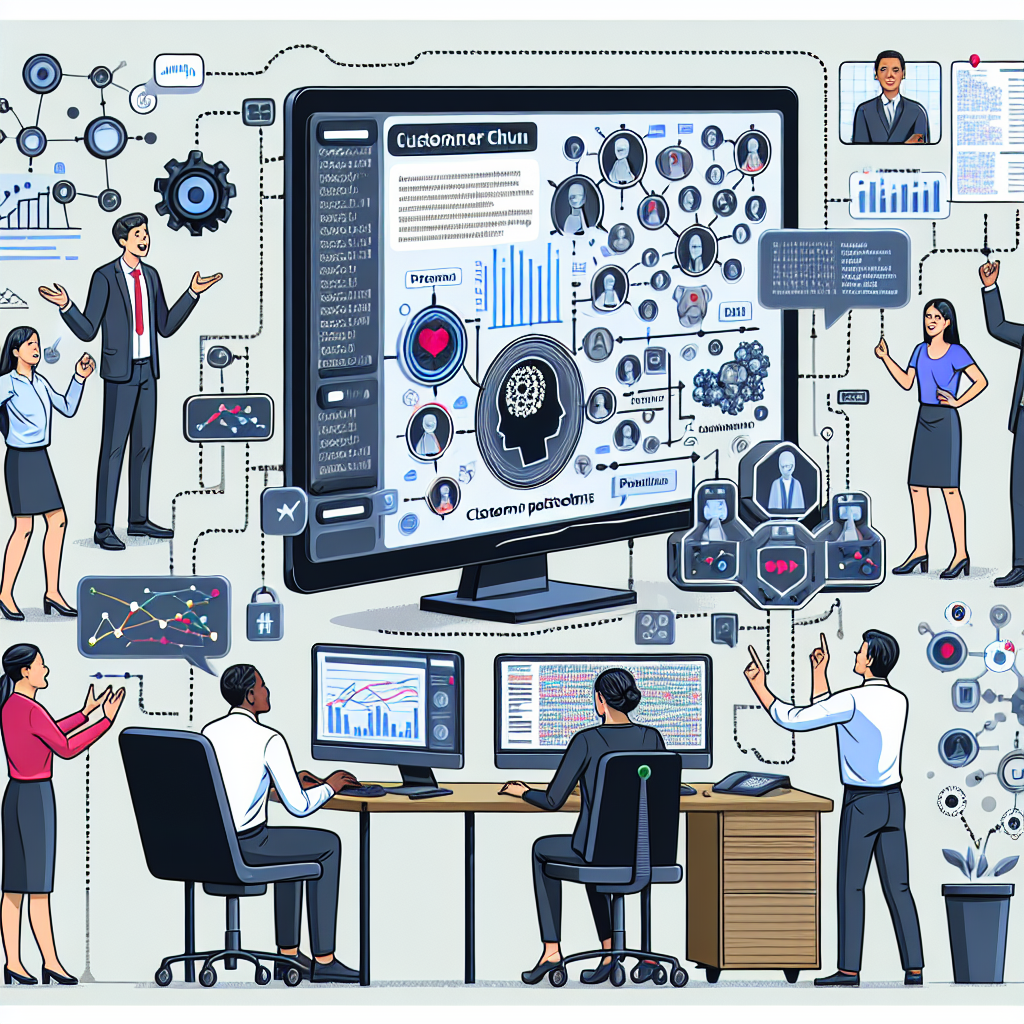
In our present-day, customer service excellence is a blend of human touch and advanced technology. One valuable tool at a business' disposal is Artificial Intelligence (AI). AI plays an instrumental role in predicting and preventing customer churn from call patterns. Broadly speaking, AI in customer service incorporates two critical aspects: machine learning and natural language processing. The synergy of machine learning and natural language processing technologies allows businesses to extract valuable insights and predict behaviour patterns.

Machine learning, a subset of AI, is a technology that enables systems to learn from data, identify patterns, and make decisions with minimal human intervention. When applied to customer calls, machine learning algorithms can analyse call records to identify patterns and trends that indicate potential customer churn. The ability to predict customer churn enables businesses to implement preventative measures, thereby retaining a larger customer base and improving overall customer experience.
Natural language processing (NLP), another crucial component of AI, is the technology used to aid computers to understand the human's natural language. NLP can be immensely beneficial when integrated into call systems, as it can interpret and analyse customer's spoken language during calls. Through sentiment analysis, which is a common application of NLP, companies can understand the customer's mood and satisfaction level. This understanding, in turn, feeds into predicting possible customer churn. Learn more about natural language processing here.
To put it in simpler terms, machine learning and natural language processing are behind the scenes superheroes of AI-powered customer service platforms. They work collectively in identifying potential customer churn, giving ahead of the curve insights that businesses can use to keep their customers satisfied and, ultimately, loyal. Explore more on machine learning here.
Understanding Customer Churn is crucial in today's competitive landscape. Customer churn, also known as customer attrition, refers to the scenario where customers stop doing business with a company or service. Studies have shown that it’s far more expensive to acquire a new customer than it is to retain an existing one. Therefore, high customer churn rate not only directly impacts a company's revenue, but also reflects poorly on its ability to satisfy its customers.
Data analytics play a significant role in understanding, predicting and preventing customer churn. With the use of advanced machine learning techniques, past customer behavior and trends can be analyzed to predict which customers are likely to churn. This makes early detection of potential churn customers possible.
Companies often study call patterns among other factors to predict churn. If a customer is repeatedly facing issues and making several complaint calls, or if the frequency and duration of their calls drastically reduces, these could be warning signs of impending churn. Timely recognition and understanding of these patterns allows businesses to react and retain the customer.
Artificial Intelligence (AI) is proving to be a game-changer in this area. It can not only identify patterns from massive amounts of data quickly and accurately, but also predict future trends based on these patterns. In fact, AI can even prescribe effective preventive measures to minimize customer churn based on the company's past experiences.
In a time where customer loyalty is a hard-fought battle, early prediction and prevention of customer churn using advanced analytics and AI is fast becoming a necessity rather than an option for businesses around the world. By harnessing the power of AI, businesses can ensure better customer retention, improved customer satisfaction, and sustained growth.
Increasing customer expectations and competition necessitate businesses to predict and prevent customer churn actively. One method that is gaining traction in the industry is the use of Artificial Intelligence (AI) in analyzing call patterns.

AI algorithms can study several elements of call data, such as call frequency and duration, or even more subtle characteristics like tone of voice. These components can potentially expose dissatisfaction among customers who might be contemplating churn.
Call frequency and duration deliver essential insights into customer engagement. More prolonged and frequent interactions typically indicate satisfied customers
However, a sudden drop in these two aspects might be a sign of increasing dissatisfaction.
Furthermore, AI can even look into the tone of customers' voices during calls. This advanced analysis could disclose the customer's emotional state. As discussed by ABC Corporation, AI tools can detect signs of frustration or dissatisfaction, which may trigger preventive measures.
AI, with machine learning capabilities, can predict churn by detecting call patterns. The system can learn from past data, identify patterns, and can predict future events based on these patterns. This isn’t just speculation; businesses have already started to gain from it. For instance, Verizon successfully implemented AI to predict and reduce customer churn.
In conclusion, AI-based prediction and prevention of customer churn using call patterns can significantly reduce customer attrition, thereby boosting profitability and enhancing customer relationships.
In the dynamic world of AI applications, there are exciting instances of how AI innovations have impacted businesses remarkably. The story of AI's success in predicting customer churn and aiding in its prevention deserves special mention. Here are a few compelling case studies where AI shone in this regard.
Telecom companies worldwide handle vast volumes of calls daily, and the task of identifying patterns that hint at potential customer churn can be overwhelming. Attract.ai, achieved notable success in this context. They used their Machine Learning algorithms to analyze historical call data, processing the voice of customers to detect emotions and sentiments. These calculations fed into their advanced AI model, which then accurately predicted customer churn and helped the company to initiate proactive retention measures.
Moving to the banking sector, the AI solution Upstox employed was also impressive. The enormity of client call records was made manageable by an AI system using Deep Learning methods. It not only pinpointed churn-significant call patterns but also suggested optimal retention strategies. The result was a substantial reduction in customer churn.
Lastly, a high-profile instance comes from the e-commerce giant, Amazon. They had implemented a state-of-the-art AI model called Digital Customer Attrition Prediction System aimed at identifying at-risk customers by analyzing call patterns and online behavior. It gave Amazon a competitive edge by enabling them to act before losing a customer.
The above success stories serve as potent evidence that AI, with its predictive and preventative capabilities, can be a game-changer for businesses striving to safeguard their client base. Thus businesses that have not yet integrated AI into their customer service strategies should consider doing so.
With the exponential growth in technology, businesses nowadays have journeyed beyond the traditional methods of assessing and mitigating customer churn. One significant advancement that's reshaping customer churn prevention strategies is the adoption of Artificial Intelligence (AI).
AI-based churn prediction models hold remarkable potential in preventing customer churn by analyzing customers' call patterns. These models assess numerous variables and utilize algorithmic mechanisms that can readily detect and interpret patterns, which may otherwise go unnoticed by human analysis.
The decision to incorporate AI tools into existing customer service systems, however, demands careful consideration. The first factor to consider is the technical compatibility of the AI churn prediction tool with your current systems. It's important to ensure seamless integration, which can be achieved via APIs or through custom development, depending on your system.

Secondly, take into account the scaling factor. As your business grows, the churn prediction tool should be capable of handling a higher volume of data and provide consistent accuracy.
Thirdly, data security is a critical factor. The selected AI tool must comply with global data protection regulations like GDPR. Also, consider if the AI tool is capable of processing sensitive data while maintaining crucial security protocols and assuring customers that their data is in safe hands. A good starting point is to consult a pocket guide on GDPR compliance.
Furthermore, AI transparency is essential. The software you adopt must provide transparent logs and reports, facilitating the process of understanding why customers are unhappy, enabling you to directly address their pain points.
Lastly, remember that as much as AI can be a gamechanger, it is only as good as the person who uses it. Utilizing these tools requires new skills and approaches. Hence, allocate sufficient resources for proper AI-retraining for your customer service agents.
In a nutshell, effectively implementing AI churn prediction tools requires technical compatibility, scalability, security, transparency, and effective retraining. With thoughtful execution, AI can be a crucial ally in predicting and preventing customer churn from call patterns.
The future of AI in customer retention lies in its ability to predict and prevent customer churn. By analysing patterns in customer phone calls, AI can identify potential red flags that suggest a customer may be considering leaving. With this information, businesses have the opportunity to intervene, adjust their strategy and ultimately retain the customer.
Pattern recognition is at the heart of this process. Advanced machine learning algorithms sift through thousands of interactions, learning to detect subtle signs of dissatisfaction or frustration. Over time, these systems only become more adept at spotting potential churn threats. It’s a proactive, data-driven approach to customer retention.
Looking forward, two key trends are emerging in this space. First, there’s an increasing emphasis on AI interpretability - understanding how AI reaches its conclusions. This has potential applications in customer retention, as it can provide insight into why certain call patterns correlate with increased risk of churn. Using these insights, businesses can seek to address the root causes of customer dissatisfaction, rather than just the symptoms.
Secondly, there's the concept of Reinforcement Learning (RL). Here, AI doesn’t just learn from historical data; it can test different approaches, learn from its mistakes, and gradually improve its performance. In customer retention, RL algorithms could put forward recommendations on how to communicate with at-risk customers, constantly refining their strategies based on feedback.
Surely, AI opens up exciting prospects for identifying and mitigating customer churn. As technology continues to evolve and these predictive systems become even more refined, the role of AI in customer retention may become integral to businesses, turning customer insights into action.
Start your free trial for My AI Front Desk today, it takes minutes to setup!








